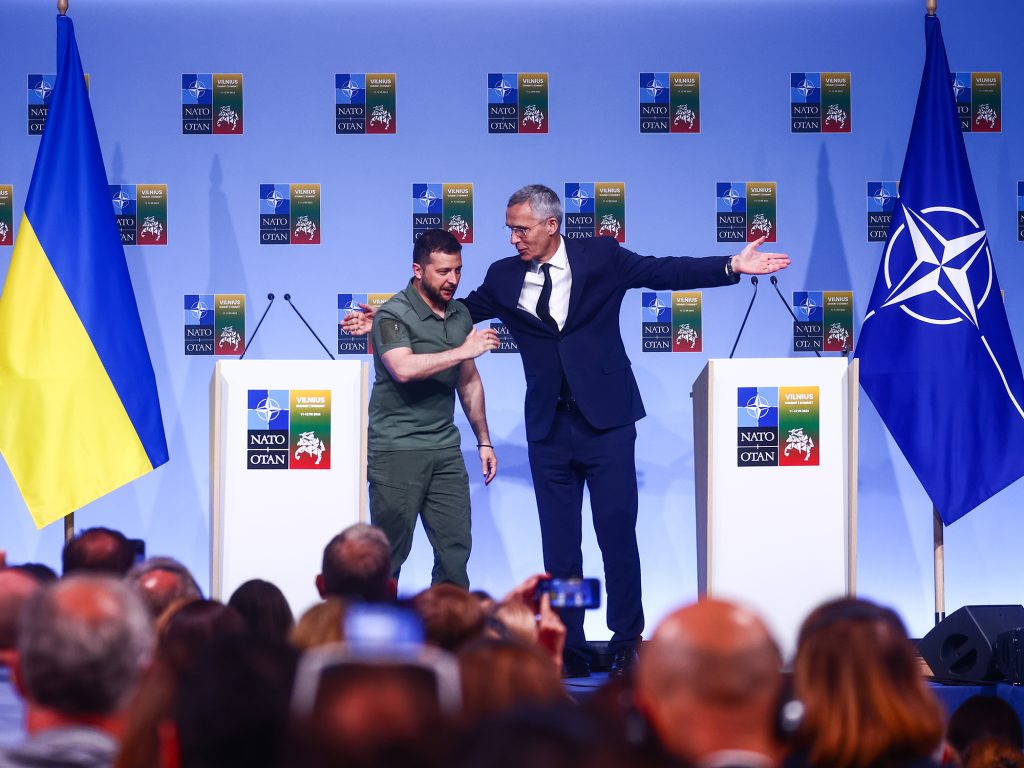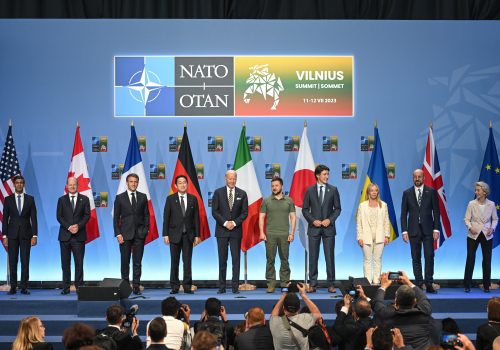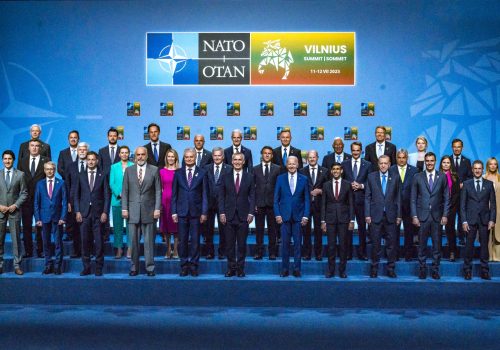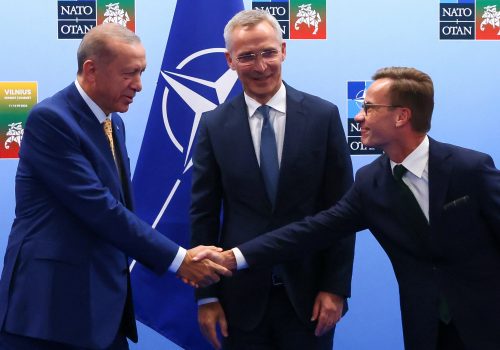VILNIUS—Drafting NATO Summit communiqués is usually less the stuff of high drama and more mind-numbing bureaucracy.
But that wasn’t the case this week. The NATO Summit in Lithuania will be remembered both for the public fireworks over Ukraine’s aspirations for Alliance membership and outcomes that included a breakthrough on Swedish membership, the most detailed and robust defense plans since the Cold War, and unprecedented Group of Seven (G7) defense commitments to Kyiv.
Let’s start with the fireworks, unusual in a consensus-driven Alliance that values decorum and discretion, and end with the historic outcomes.
Tensions began simmering long before the summit among Biden administration officials and other NATO allies—with Ukraine lobbing arguments from the outside—over just how far to go in committing the Alliance to a time-linked invitation and roadmap for Ukraine’s membership.
For the Biden administration, it was a matter of geopolitical prudence to oppose any fixed timeline for an invitation for fear it would draw NATO, and hence the United States, into a direct conflict with Russia. With one eye on the 2024 US presidential election and the other on Russian President Vladimir Putin’s nuclear capabilities, why take the risk, particularly as full Ukrainian membership wasn’t likely to come before the war ended anyway?
For Ukraine’s more impatient supporters—particularly, but not exclusively, those geographically closer to the Russian threat—it was a matter of strategic imperative and moral obligation to draft language that provided more clarity on the pathway and potential timing of a NATO membership invitation than Washington considered acceptable. Several of those supporters had previously been occupied and repressed by Moscow, so they understand the value of NATO security guarantees.
Even if membership itself wouldn’t come for some time, they wanted to demonstrate maximum common cause for a people who miraculously and at enormous human cost are countering Russia’s war and revanchist ambitions.
The behind-the-scenes simmer boiled over when Ukrainian President Volodymyr Zelenskyy, apparently having read a draft of the summit communiqué about to be released, threw a Twitter bomb into the negotiating room.
What he objected to was text at the end of paragraph eleven, which read: “We will be in a position to extend an invitation to Ukraine to join the Alliance when allies agree and conditions are met.”
Zelenskyy shot back before the draft could be released:
“It’s unprecedented and absurd when time frame is not set neither for the invitation nor for Ukraine’s membership. While at the same time vague wording about ‘conditions’ is added even for inviting Ukraine. It seems there is no readiness neither to invite Ukraine to NATO nor to make it a member of the Alliance. This means that a window of opportunity is being left to bargain Ukraine’s membership in NATO in negotiations with Russia. And for Russia, this means motivation to continue its terror. Uncertainty is weakness. And I will openly discuss this at the summit.”
Before long, word spread in Vilnius that at least one ally had “broken silence,” which in NATO-speak means that during an agreed period after the communiqué has been finalized and before it is publicly released, any ally may come back with an objection and reopen negotiations.
Though it’s unclear what transpired next, officials involved in the negotiations described scenes during the summit in which US President Joe Biden and National Security Advisor Jake Sullivan stood over the document and hand-drafted changes. In the end, the US stance on Ukrainian membership proved immovable, even resisting attempts by at least one other ally to at the very least state that it was NATO’s intention to explore ways to invite Ukraine to join the Alliance as soon as the seventy-fifth-anniversary summit in Washington next July.
Given all that, there was more than a little buzz when Biden, in his fiery speech in Vilnius—in which he hailed the “unbroken” Ukrainian people—neglected to mention or encourage their NATO membership aspirations.
Even after NATO made the communiqué public, tensions still simmered.
At the NATO Public Forum, (a side event for the summit that the Atlantic Council co-hosted), Daria Kaleniuk, a Ukrainian anti-corruption activist, provocatively asked Sullivan how to explain to her young son, who is sleeping in their corridor due to air raids, that Biden isn’t ready to accept Ukraine into NATO. She suggested it might be “because he is afraid of Russia, afraid of Russia losing, afraid Ukraine winning,” or even suggested, “because there are back-channel negotiations with Russia” that ostensibly had Ukraine’s NATO hopes as a bargaining chip.
Sullivan was warm but firm to his questioner, acknowledging that the world stands in “awe” at the way Ukrainians have made sacrifices with “hell raining down from the skies” around them. At the same time, he scolded Kaleniuk for making “insinuations” that were “unfounded and unjustified” and asked that those insinuations “get checked at the door, so that we can talk to one another in goodwill and good faith.”
Beyond that, Sullivan added, “I think the American people do deserve a degree of gratitude” from both the US government and the rest of the world “for their willingness to step up” to provide such plentiful military assistance to Ukraine.
With tensions high, British Defense Minister Ben Wallace hit a similar theme, “providing a slight word of caution” that Ukraine should express more appreciation to its supporters.
When asked by reporters for his response to Wallace, Zelenskyy replied, “he can write to me about how he wants to be thanked.”
Were it not for the fireworks, the world’s focus would have been more singularly on the summit’s results.
Turkish President Recep Tayyip Erdoğan dropped his objections to Sweden’s membership, opening the way for it to join the Alliance. That leaves Putin facing a bigger and more unified NATO, strengthening defense in the Baltic states and the High North.
Real progress also came through a pledge by G7 countries (all in NATO except Japan), although it is not binding, to provide Ukraine “enduring” support—which each country will determine individually—including more defense equipment, increased intelligence sharing, and expanded training, dramatically reducing the likelihood of eroding resolve.
There was plenty more in the NATO Summit communiqué on defense plans, strengthened commitments to defense investment, and deeper global partnerships, particularly with leaders on hand from Australia, New Zealand, Japan, and South Korea; there was also robust language on China and warnings not to provide lethal support to its Russian friends for their Ukraine war.
By summit’s end, and by the convening of the renamed and reconstituted NATO-Ukraine Council, tempers had calmed some and diplomacy had intervened on the Ukraine issue, though some bad blood will likely linger.
Zelenskyy went home not with a NATO invitation but with family photo-like pictures alongside NATO leaders, as mentioned in my Inflection Points column last week, and a dramatically different tone than his earlier missive, as shown in a video he tweeted from his train ride home to Kyiv:
“We are returning home with a good result for our country and, very importantly, for our warriors… For the first time since independence, we have formed a security foundation for Ukraine on its way to NATO. These are concrete security guarantees that are confirmed by the top seven democracies in the world. Never before have we had such a security foundation, and this is the level of the G7… Very importantly, during these two days of the [NATO] Summit, we have put to rest any doubts and ambiguities about whether Ukraine will be in NATO. It will! For the first time, not only do all the allies agree on this, but a significant majority in the alliance is vigorously pushing for it.”
At a closing session for the NATO Public Forum, I asked Lithuanian Foreign Minister Gabrielius Landsbergis how history would remember the Vilnius summit.
“Strategically, we won,” he said. “We committed ourselves to Ukrainian membership in NATO.” Unlike the 2008 commitment at the Bucharest NATO Summit that had no follow up, Landsbergis said the Alliance and Ukraine this time won’t waste another day, because of the urgency that Putin’s war had placed on everyone.
The Vilnius summit “was not the last stop,” he said. “We have to see it as a bridge. And the next stop is Washington. So, we have a full year. Lots to do…. Washington can actually be even more historic than Vilnius.”
Frederick Kempe is president and chief executive officer of the Atlantic Council. You can follow him on Twitter @FredKempe.
THE WEEK’S TOP READS
#1 NATO’s promises to Ukraine mark real progress
ECONOMIST
The Economist reports that although NATO allies could have done more at this week’s summit in Vilnius, they dealt a number of blows to Putin that went far beyond Ukraine.
“Putin’s first defeat was over a different expansion of NATO,” the Economist writes. “Turkey’s president, Recep Tayyip Erdoğan, said he is dropping his objections to Sweden’s membership, enabling it to follow its Nordic neighbor, Finland, into the alliance. That will strengthen the Baltic states and the High North, and tie up more of Putin’s resources should he attempt mischief against NATO anywhere along its frontier.”
Further, with increased military assistance from G7 countries, it will become harder for Putin to maintain his resolve. “The G7 members promise that this will be an ‘enduring’ commitment, and that each country will, individually, craft its own security guarantees for Ukraine that will give it a ‘sustainable force capable of defending Ukraine now and deterring Russian aggression in the future.’… This matters because it helps disabuse Putin and his elites of the belief that Western resolve will crumble if only Russia clings on.”
Although delaying Ukraine’s NATO membership process until after the war will likely give Russia incentive to prolong the war, the Economist argues, the additional military assistance should prevent that from happening. “That is where the summit made real progress.” Read more →
#2 The ‘Israel Model’ Won’t Work for Ukraine
Eliot A. Cohen | ATLANTIC
In this important Atlantic piece, Eliot Cohen argues that the “Israel model”—in which the West would arm Ukraine to the teeth to guarantee its ability to defeat any credible military threat—is a poor policy choice based on flawed reasoning.
Cohen writes that the main difference between 1973 Israel and 2023 Ukraine is that Israel had a military edge over its neighbors, which Ukraine currently lacks over Russia. “Israel staged bombing raids against targets deep in Syria and Egypt, including their capitals, from the 1960s forward, and unlike the Ukrainian drones flying to Moscow, these were not mere symbolic strikes. The Six Day War, in 1967, was an overwhelming Israeli victory, which involved the annihilation of its neighbors’ air forces and the advance of Israeli armor and infantry across the de facto 1949 border. The 1973 war similarly ended with Israeli forces within artillery range of Damascus and on the verge of destroying half the Egyptian force that had crossed the Suez Canal.”
Most provocatively, Cohen writes about the difference between an Israel with a nuclear arsenal and a Ukraine that gave up its nuclear weapons in 1994 in a deal under which Moscow promised to safeguard its sovereignty and security. “Unless, of course,” Cohen warns in his conclusion, “[Biden] prefers to be the father of the Ukrainian atom bomb.” Read more →
#3 Russia’s Nuclear Option Hangs Over Ukraine and NATO
Robbie Gramer | FOREIGN POLICY
To gain an understanding of how fears of nuclear conflict played into this week’s decision, read Robbie Gramer in Foreign Policy.
“The nuclear question is an existential one for the alliance,” he writes, “one that’s driven Washington’s calculations on what military aid to send to Ukraine and when, and it has also influenced the debate on when and how to allow Ukraine to join the military alliance as a full-fledged member.”
According to Gramer, US and allied officials are divided over the validity of Russian threats. “Some US and other NATO defense officials believe there could be an increased risk of Russia launching a limited nuclear strike with a low-yield tactical nuclear weapon to stave off a major battlefield defeat if its forces look to be on the verge of a rout, or if Ukraine appears poised to capture Crimea and large swaths of occupied territory in southern and eastern Ukraine. Others say that Russian President Vladimir Putin’s nuclear saber-rattling won’t go further than that, and bowing to such threats will only embolden Russia to use such ‘nuclear blackmail’ in the future.”
“At the same time, Ukrainian and Western officials also fear that Russia could mount an attack on Ukraine’s Zaporizhzhia nuclear power plant to attempt to trigger a major radiological event, irrespective of whether it launches a nuclear strike—though it’s unclear how successful those efforts would be.” Read more →
#4 Biden Pledges Long-Term Backing for Ukraine, but a U.S. Election Looms
Zolan Kanno-Youngs | NEW YORK TIMES
For insight into the role of US domestic politics on the NATO summit and Biden’s decision making, look no further than Zolan Kanno-Youngs’s reporting in the New York Times.
“Despite Biden’s repeated promises of staying by Ukraine’s side in its war against Russia, questions about the shelf life of support among American people and lawmakers hung over the summit of Western allies,” Kanno-Youngs writes. “Even as the US president was giving a long-term commitment, a group of far-right Republican lawmakers in Washington was pushing legislation that would scale back aid to Ukraine, exposing fractures in the Republican Party and raising doubts about its commitment should it capture the White House next year.”
According to Kanno-Youngs, to sway domestic public opinion to favor providing aid to Ukraine, Biden has framed the war as an existential battle between democracy and autocracy. In Vilnius, Biden was determined to address the doubts about continued US support for Ukraine. “We will not waver,” Biden said. “I mean that. Our commitment to Ukraine will not weaken.” Read more →
#5 Should Ukraine Negotiate with Russia?
Dmytro Natalukha; Alina Polyakova and Daniel Fried; Angela Stent; Samuel Charap | FOREIGN AFFAIRS
In dialogue with Samuel Charap, who previously urged the use of diplomacy as a tool to end the war with Ukraine, Dmytro Natalukha, Alina Polyakova and Daniel Fried (an Atlantic Council distinguished fellow), and Angela Stent argue that negotiations with Russia are bound to fail. Read this multifaceted analysis to understand the pros and cons of negotiation with Russia.
Natalukha claimed that the only way to secure Ukraine’s future is to remove Putin from power. “If the goal is to prevent Russia from threatening democracies around the world, allowing it to reach an armistice with Ukraine won’t do much good,” he writes. “Ukraine and its allies must aim to make Russia less anti-Western. Regardless of what happens at the negotiating table, therefore, Putin cannot remain in power.”
Polyakova and Fried believe that although negotiation will most likely happen, the battlefield is Ukraine’s best position from which to win the war: “A military stalemate is indeed possible. And at some point, negotiations with Russia will be needed to end this war. But Ukraine should start negotiating only when it is in the strongest possible position; it should not be rushed into talks when Russia shows no interest in any settlement terms other than Ukraine’s surrender. Starting negotiations now would mean accepting Putin’s maximalist terms. If Russia suffers further setbacks on the battlefield, however, talks could proceed from a better starting place.”
Polyakova and Fried continue, “The most important point, which Ukraine’s allies agree on, is that Ukraine must define the right moment for negotiations. That may or may not be when all of Ukraine’s territory is liberated. The key is for Ukraine to maintain flexibility in its decisions about its territory and the path toward a just peace.” Read more →
Atlantic Council top reads
Image: President of Ukraine Volodymyr Zelenskyy and Jens Stoltenberg, secretary general of NATO, attend the press conference during NATO Summit at LITEXPO Lithuanian Exhibition and Congress Center in Vilnius, Lithuania on July 12, 2023. Photo by Beata Zawrzel/NurPhoto via Reuters.



